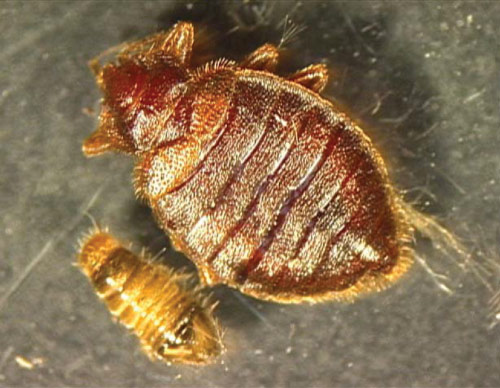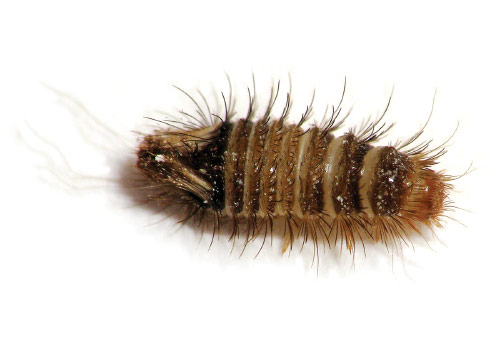Carpet Beetles in Kindergarten
 |
|
A typical kindergarten classroom. Photo by woodleywonderworks: flic.kr/p/5kUqG8 (CC BY 2.0). |
By Marcia Anderson, PhD; U.S. EPA
A few weeks into the school year, some preschool and kindergarten students went to the school nurse with red welts on their legs. The welts were large and itchy, with a burning sensation. This told the nurse they weren’t mosquito bites.
In the coming days, the problem escalated until students from different classrooms were also getting similar welts on their legs. Some students seemed to be affected daily while others in the same classrooms had no welts at all. Students would recover over weekends, only to get worse when they came back to school. This continued for two months.
An Elusive Culprit
Carpet beetles are like bed bugs in that they are very tiny and hard to find. The difference is, bed bugs bite. Carpet beetles do not.
Mosquitoes, lice, fleas, spiders, bed bugs? The usual suspects were eliminated one by one. The nurse reported the problem and a pest-management professional (PMP) came to investigate.
The PMP suspected carpet beetles because only some children were being affected. Almost everyone has some sensitivity to bed bug bites, but only some people are allergic to carpet beetles. And carpet beetles were just what the PMP found!
Carpet Beetle Basics
 |
|
Bed bug compared with a carpet beetle larva (left). Photo by Dr. Gale E. Ridge, The Connecticut Agricultural Experiment Station. |
Carpet beetles are like bed bugs in that they are very tiny and hard to find; they harbor in bedding, carpets, and piles of clothes, and prefer to feed in dark, undisturbed, protected places.
The difference is, bed bugs bite. Carpet beetles do not.
Carpet beetles regularly invade homes, where their larvae eat a variety of natural fibers like wool, leather, and feathers. Carpet beetle larvae are small, hairy caterpillars that shed their skins as they feed to keep growing.
Inadvertently Inviting the Pest
Through further investigation, the nurse discovered that the reading areas in the affected classrooms had new, natural-fiber carpets installed the preceding summer.
Vacuuming is the best way to remove the animal hair and lint that serve as food for carpet beetle larvae.
When the children moved around on the new carpets, especially on dry days, there was a buildup of static electricity that caused fine hairs of the carpet beetle larvae to pass though all but the finest weaves of clothes and make contact with the children’s skin. This created pin-prick wounds that looked similar to insect bites.
Treat the Problem at the Source
Chemical controls were not needed, as adult carpet beetles do not cause allergic reactions. The prickly hairs of the shed larvae skins do. The solution was simple: remove the allergens (shed skins) and any remaining larvae from the carpets.
The school had the carpets vacuumed and then steam cleaned, and the problem was solved. Placing carpet beetle traps in the classrooms to catch any remaining adults—so there would be no more larvae in the carpets—completed the treatment.
In school or at home, the best way to avoid carpet beetle larvae is through prevention. Vacuuming is the best way to remove the animal hair and lint that serve as food for carpet beetle larvae. Animal-based fabrics should be dry-cleaned or laundered before being stored for long periods. Cleaning not only removes perspiration odors that attract the beetles, it also kills any eggs or larvae.
Safe, Effective Management
 |
|
A varied carpet beetle larva. Photo by Ashley Bradford, Maryland Biodiversity Project. |
A comprehensive integrated pest management (IPM) program includes prevention, sanitation, pest identification, and monitoring, and can be followed by carpet beetle traps. IPM favors cost-effective methods that protect human health and the environment.
The traps use a pheromone to attract and capture the adult male carpet beetles. Traps can be placed on the floor or on a windowsill, or hung in a pantry or closet. The traps are non-toxic and easy to use, and they should be replaced every two months or when they are filled with insects, whichever comes first.
If necessary, there are several pesticides, both synthetic and natural, labeled for use against carpet beetles. When using off-the-shelf products, be sure to read the label carefully and follow directions.
Know the Pests and What Attracts Them
Remember that carpet beetle larvae will eat anything at your school or home that is made of natural fibers—from rugs to clothes to furniture.
If you see a tiny beetle crawling or flying around, examine it closely or get a professional to determine whether it’s a carpet beetle. Always contact your facility maintenance staff to determine the most effective means for resolving the problem.
The Northeastern IPM Center promotes integrated pest management for reducing risks to human health and the environment. If republishing our news, please acknowledge the source (“From Northeast IPM Insights”) along with a link to our website.
